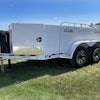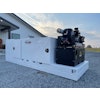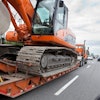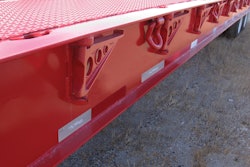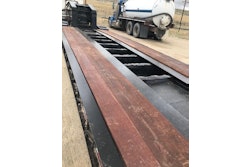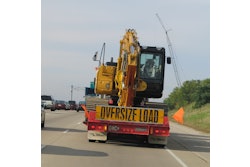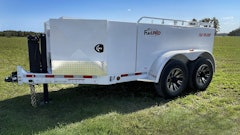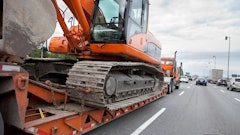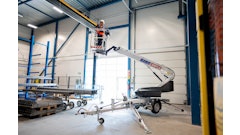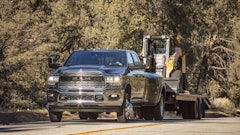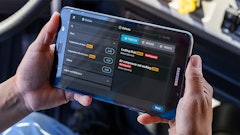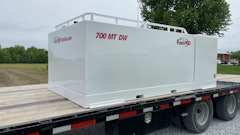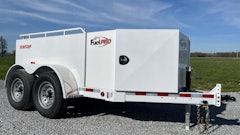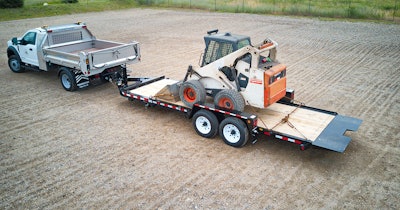
Trailers are designed to safely and efficiently haul your equipment and material without worrying about your load on the road. However, safe loading and hauling really comes down to the actions of the operator. Driving a truck with a trailer full of expensive equipment can be an intimidating experience. Make sure you’re taking all the steps and precautions necessary to keep you, other drivers and your equipment in good shape for years to come.
Safety Preparation
1. Check Clearance Of Trailer
Measuring the height of your trailer with your equipment loaded is an important step in staying safe on the road. Make sure you are within your state’s clearance requirement limits and also check your route ahead of time to avoid any tunnels or bridges that may be too low for the equipment you’re hauling.
2. Load On As Level of Surface as Possible
A level surface is important to make sure you’re accurately distributing the weight of the equipment or material you’re hauling. If you load on an uneven surface, your equipment could shift on the road leading to uneven weight distribution, tipping, and other handling complications.
3. Chock Wheels
Chocking your wheels is an easy way to prevent shifting when loading your trailer. Chocking is a simple safety maneuver that can ensure you and your truck are safe and steady even before you hit the road.
4. Clean Trailer Top
Giving the top of your trailer a quick sweep can get rid of small stones and other debris that may bounce on the road–preventing it from hitting other vehicles.
5. Use Two People Whenever Possible
If possible, have another operator close by to check your work, check your connections and spot anything you may have overlooked while you were setting up your trailer.
6. Physically Touch Your Connections
Physically touching your connections can catch loose attachments that may not be visible by sight alone.
 Towmaster
Towmaster
Safe Securement
The Federal Motor Carrier Safety Administration (FMCSA), a part of the United States Department of Transportation, has a set of cargo securement regulations in place to protect you, your cargo, and all other drivers around you.
The regulations call for cargo to be "firmly immobilized" or secured in a way that prevents unfastening, opening or releasing while in transit. Equipment that is likely to roll must be restrained with chocks.
All tiedowns, and other securement systems used to secure loads on trailers equipped with rub rails, must be located inboard of the rub rails whenever practicable. When a tie down is in contact with a sharp area of your cargo, it must be specially protected to avoid abrasion, cutting and crushing. Learn more at www.fmsca.dot.gov.
Your equipment has a minimum number of tiedowns required. The number of tiedowns depends on the size of your equipment.
- 1 tie down for 5ft or less in length and 1,110lbs or less in weight
- 2 tie downs for 5ft or less in length and more than 1,100 lbs in weight
- 2 tie downs for greater than 5 ft and less than 10ft in length, regardless of weight.
How to Balance Weight
Where Does Your Equipment Hold Its Weight?
The most fundamental piece of information you need while loading your equipment is understanding how much each unit weighs and where the unit “carries” the weight. For example, skid loaders carry most of the weight in the back of the unit. This information will help ensure you are able to actually balance the weight of the equipment itself, not just based on how heavy each piece looks.
Follow the 60/40 rule
The 60/40 rule should always be followed when loading your equipment. 60% of the loaded weight should be placed in front of the center axle and the other 40% will then be placed behind the center axle. This ensures your load is not front or back heavy. If possible, work toward 50/50 side-to-side weight distribution.
Look for balance in tire distance
When you take a step back, does it look like either end of the trailer is “lifting” or even being dragged down? Does the pressure between all of your tires look equal? Does your truck look like it’s about to go into a wheelie? If you answered yes to any of these questions, your weight is likely off balance.
Staying Safe
Check Load Frequently
Checking your load semi-frequently helps to ensure you’re staying safe on the road. Check after the first handful of miles (around 20), then stop every 150 miles to do routine inspection. Drivers are in fact legally responsible for making these stops in accordance to the National Safety Code Standard 10 Cargo Securement (Division 1, Sections 2 and 3) as well as the FMCSR (392.9).
During these stops, make sure you’re maintaining the safety of your equipment and trailer by tightening any straps that may have loosened on the road. Take a look at the lights, tires, hitch and wiring system to make sure everything is still working properly. These stops are also a good opportunity to look ahead and plan any preventative maintenance and repairs for systems that may need a tune up in the future.
Pay Close Attention To Turns and Hills
Sharp turns and driving on hilly roads (especially on the way down) are particularly difficult situations to maneuver with a trailer full of equipment. As you anticipate breaking, make sure to start slowly and as soon as possible so you can maintain a safe distance between you and other vehicles. On unavoidably sharp turns, make sure to take a wide berth. This will help to make sure your trailer doesn't hit or ride on curbs.
Be Aware of Weight Capacity
When you invest in a trailer, you of course make sure that the equipment you’re loading is within the weight limits of your trailer. However, if your business changes or grows, you may find yourself needing to haul different equipment or materials. Make sure you do the quick math to ensure you’re still within safe and legal hauling limits.


